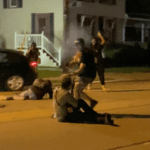“The main colors of Missouri are:
Green for the grass and the trees
Blue for the sky and the lakes
Brown for the bricks, the dirt, the mud, the rivers—and the bullshit.”
-me, November 18, 2003
Missouri has always had an identity crisis. We don’t know if we’re Southern or Midwestern. Missouri had a star on both the Union and the Confederate flags during the Civil War. It’s no wonder we don’t know what we are. We come by it honestly.
We are a microcosm of the nation. We have big cities and we have small towns. We have mountains (by our standards anyway) and we have flat lands. We have rivers and we have lakes. We have farms and we have forests. We have every kind of weather imaginable and several kinds of weather that aren’t. We get scorching heat, freezing cold, tornadoes, wind, hail, droughts, floods, and blizzards. We even have earthquakes because, I mean, why not?
(Some might say Missouri is landlocked; one look at the Mississippi River during a major flood will cure you of that misconception.)
We aren’t as ethnically diverse as some states, but we have a little bit of everything. Religiously speaking it’s not exactly a smorgasbord here, but we have a lot more going on than say, West Virginia. The Trump worshippers are the newest cult on the block, but hopefully that doesn’t have much of a shelf life.
Perform this thought experiment: when you imagine a New Yorker, what do you see in your head? How about a Texan? A Hawaiian? A Minnesotan? Maybe a Louisianian? You form instant assumptions about persons from those locales because their states have strong identities.
When you think of a Missourian, you likely think of… nothing in particular. And what does come to mind may not be favorable. Hillbillies? Rioters? Farmers? Toothless meth addicts? Mark Twain? Harry Truman? Fredbird? Nelly? Mules? All of the above? None of the above?
We can be all of those things because we have tremendous range. We belong to no region and therefore in a way we belong to every region. We were probably wonderful spies for both sides during the War Between The States.
So forgive us if we don’t know up from down or left from right sometimes. We do our own thing. Whatever that is.
It is my belief that this confusion goes back to our conception as a state. Even that was a subject of controversy. The Missouri Compromise admitted Missouri as a “slave” state, but only on the condition that Maine (up to then a part of Massachusetts) be admitted as a “free” state to keep the slave/free balance in the U.S. Senate even. To further muck things up, the “compromise” outlawed future slavery north of 36°30′ parallel…except for Missouri itself, which sits entirely north of that parallel except for the Bootheel. Right off the bat, we were weird.
Slavery (a.k.a. “the most un-libertarian thing ever”) was hardly a settled issue in our newborn state, however. Slavery never seriously took hold in the Ozarks or in St. Louis. It flourished mostly in the flat lands of southeastern Missouri and the “Little Dixie” area along the Missouri River in the central part of the state.
Then came waves of German immigration from the various German states following the German Revolutions of 1848-1849. These Germans were largely liberal in their political thinking (for their time) and settled in St. Louis and the hills of central and southeastern Missouri. They had no tolerance for chattel slavery and would later form a large contingent of the state’s Union forces.
(The subtraction of these liberal Germans from the future united Germany would help smooth the path for the rise of Bismarck and…well, you-know-who.)
Missouri didn’t even wait for the War of Northern Aggression to break out before fighting… Kansas. The stories of the Bushwhackers vs. the Jayhawkers are brutal and legendary.
After getting a head start on the hostilities, Missouri predictably got even worse once the rest of the nation got in on the action following Fort Sumter. Missouri had a secessionist governor and for a while had two competing state legislatures. We sent Representatives and Senators to both Washington and Richmond. Missouri seceded but didn’t really secede, depending on who you asked. The two largest battles of the war west of the Mississippi River were fought on the soil of our very confused state.
The big war (by whatever name you want to call it) settled the slavery question, but Missouri continued to be a hot mess even afterwards. After Reconstruction, it became a mostly reliable Democratic state. (And as a reminder, back then the Democrats were largely the more conservative of the two major parties.)
After all, it’s not the GOP that is mentioned in the famous quote by Rep. Willard Vandiver that branded Missouri as the “Show Me State”:
I come from a state that raises corn and cotton, cockleburs and Democrats, and frothy eloquence neither convinces nor satisfies me. I’m from Missouri, and you have got to show me.
(Local color: Vandiver also served as president of the Missouri State Normal School, now known as Southeast Missouri State University, from 1893 to 1897. That august institution sits less than a mile from my front door, and all of it is uphill. Some have even suggested that the university be re-named in Vandiver’s honor, as “directional” names for colleges are now considered somewhat gauche.)
In presidential elections, Missouri voted Democratic along with the sore loser Solid South from 1872 to 1900. In the twentieth century, Missouri became somewhat more politically balanced. The GOP made significant inroads, carrying the state in the presidential elections of 1904, 1908, 1920, 1924, and 1928.
Missouri was famously a “bellwether” state for a century, voting for the eventual presidential election winner (except once) every time between 1904 and 2004. That’s pretty impressive; a microcosm of America indeed.
Starting in 2008, however, our winning streak came to an end. Curmudgeonly, constipated John McCain won the state over Barack Obama by a hair, 3903 votes (less than one half of one percent of the total vote.) In 2012, future Bond villain Mitt Romney improved considerably on this performance, topping incumbent Obama by a more impressive 258,644 votes. In 2016, walking id Donald Trump walloped the always likable Hillary Clinton by a staggering 523,443 votes while she otherwise carried the nationwide popular vote by a significant margin. All statewide offices except one went to the GOP. Both U.S. Senate seats are in their hands. The Republicans also hold veto-proof majorities in both houses of the state legislature. “Show Me” a dominant GOP.
So what happened between 2004 and 2016? Missouri’s demographics didn’t change considerably. In fact, population growth during that time was lethargic at best when compared to many other states.
St. Louis and Kansas City remained solidly Democratic. (In fact if anything, St. Louis as a metropolitan area actually became more blue, with St. Louis County making a solid shift in that direction after being a GOP bastion for decades.)
As recently as 1999, Democrats held both houses of the Missouri General Assembly and all the state-level statewide offices. As recently as the 1996 presidential election, Democrats could still be a force outside the two major cities, with Bill Clinton carrying sixty-four total Missouri counties. By comparison, twenty years later, his wife carried only five counties.
What gives? Was Hillary that much worse of a candidate than Bill?
Well, yes. But also, from about 2000 onward, outstate Missouri experienced a Democratic purge. Over that time the “southern Democrats” largely went extinct here and in the nation in general. (I may write a piece about that someday actually, as I find that whole topic fascinating.)
Outside of St. Louis and Kansas City, our state is now essentially indistinguishable from Kentucky or Arkansas. In that sense, it is only fitting that the University of Missouri joined the Southeastern Conference in 2012. We were just getting the band back together.
(How Libertarian is Missouri? Meh. It helps that we have ballot access as long as a statewide candidate exceeds 2% at least once every other election cycle. So, for 2016 at least…you’re welcome.)
So now Missouri is a solidly red state, for better or worse. Yet, it still acts blue once in a while. Recent cases in point:
“Right to work” (allowing workers at union shops to opt out of paying union dues) was passed by the candy apple red Missouri General Assembly in 2017 and signed by then-Gov. Greitens. But then it was overturned by voter referendum in 2018 before it could take effect. And it wasn’t even close; 67.8% of votes cast were against right to work. This puts Missouri in the awkward position of being surrounded by right to work states on all sides except for The People’s Republic of Illinois. Meanwhile, such traditionally union-friendly states as Michigan (home of the “Big Three” domestic auto makers) and Wisconsin have adopted right to work laws while the Show Me State has not. Hard to figure.
A similar right to work measure failed in Missouri in 1978, going down by a margin of 60% to 40%. Somehow, in the forty years between the two votes, unions became even more popular here in spite of the state’s overwhelming turn to the GOP during that same time.
I remember my pro-union parents putting bumper stickers on their cars in 1978 claiming that right to work was a “RIPOFF.” Pro-union forces in 2018 brought back the exact same “RIPOFF” graphic for some of their campaign materials. If it ain’t broke, don’t fix it, I guess.
Clean Missouri, ostensibly a redistricting/lobbying/campaign finance reform measure, also passed fire engine red Missouri in 2018 by a similarly comfortable margin. This despite putting redistricting authority into a newly created “non-partisan demographer” position that just happens to be under the auspices of the State Auditor, not the Secretary of State (the office usually associated with election authority.) And it just so happens that the State Auditor’s office is the one statewide office currently held by Democrats. (Things that make you go “hmmm.”)
Medicaid expansion, which some see as a risky proposition due to the state’s nebulous financial obligations in the long term, passed in beet red Missouri just a few weeks ago by about a six point margin.
None of these three things are “conservative” per se, yet they went over well in streetwalker lipstick red Missouri. What gives? Do we have a secret liberal streak hidden beneath the surface of our fair state?
My guess is “no.” Outside of the two major cities and some blue pockets (mostly in college towns), Missouri is a legit conservative Republican stronghold and will likely go to Trump again by double digits in November. Our two large blue cities are not quite large enough to pull a Chicago and dominate the rest of this otherwise red state. (Plus they’re not really growing and some of their suburbs lie across state lines, serving to blunt their electoral influence.)
However, it may be fair to say that Missouri has a populist streak. Populist does not always equal liberal, though there is some overlap. Populist icons Ross Perot and Patrick Buchanan did well here, as did some “reform” issues such as term limits in the early 1990’s.
Missourians split tickets like champs and are not afraid to stray from right wing orthodoxy if it is perceived (correctly or incorrectly) as being in favor of the working or common man.
We are a state of confusion, but I think our people at least mean well. Roads paved with good intentions famously lead to bad places, but at least we are not heading in any such direction at breakneck speed.





1 comment
… [Trackback]
[…] Read More here to that Topic: thelibertarianrepublic.com/missouri-is-a-state-of-confusion-but-we-mean-well/ […]